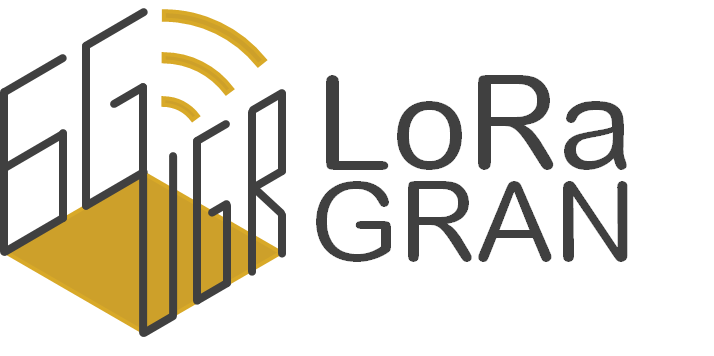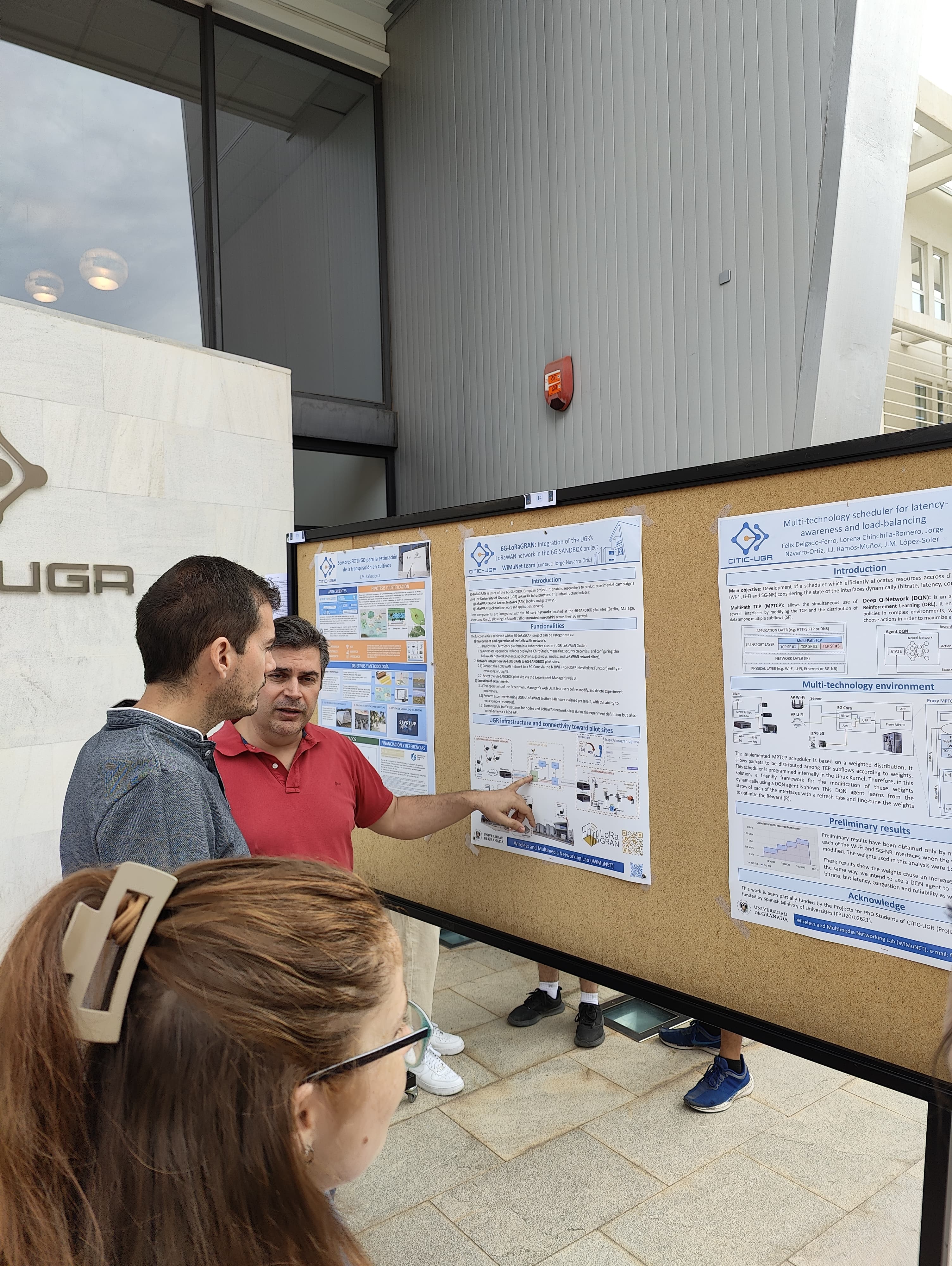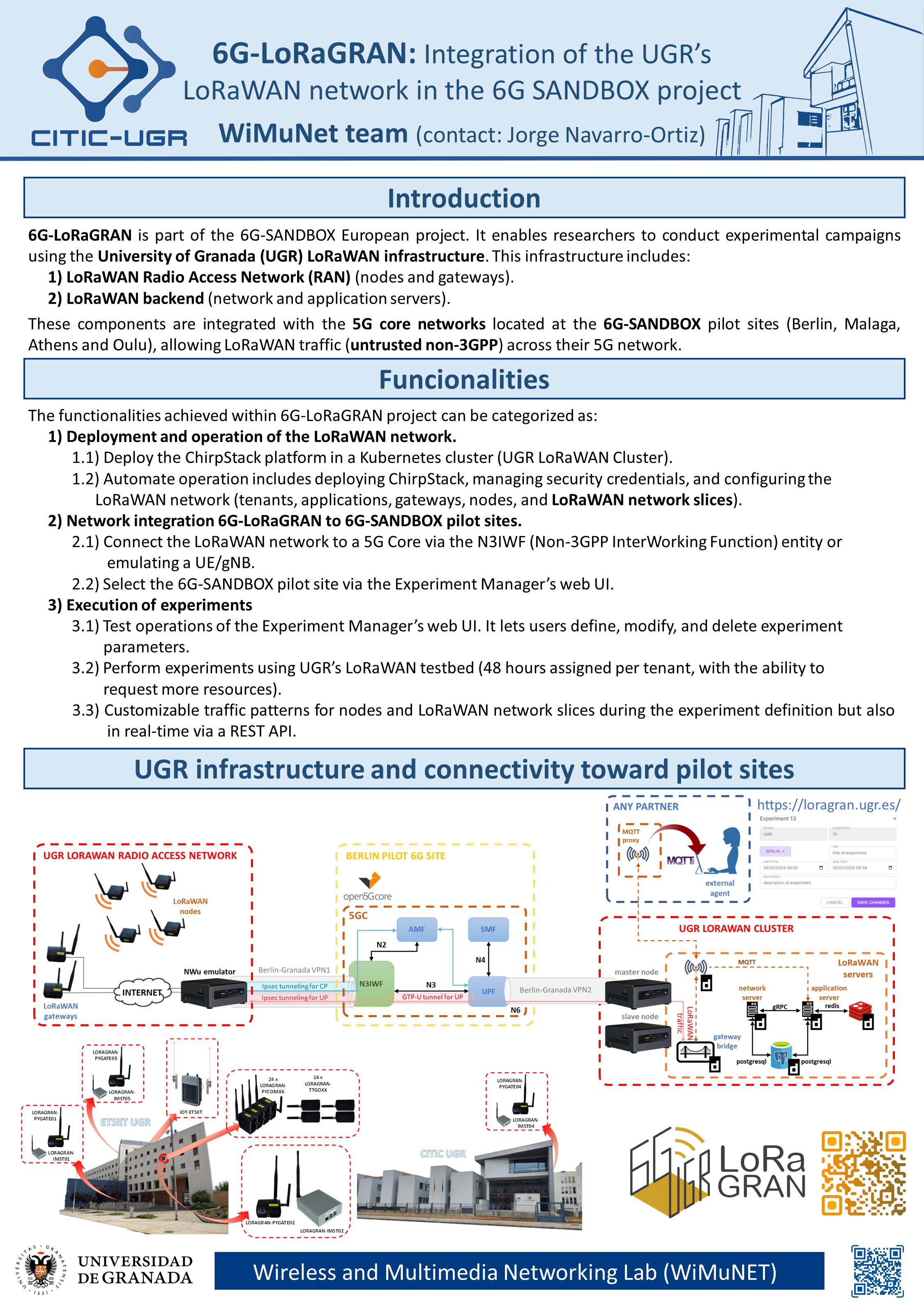
Brief Summary
Reference
-
1st 6G-SANDBOX Open Call for New
Infrastructures and Functionalities, 6G-LoRaGRAN, 09/2023-02/2024, 60.000 euros
"Integration of the University of Granada's LoRaWAN network in the 6G SANDBOX connectivity infrastructure (6G-LoRaGRAN)", Jorge Navarro-Ortiz, 2023
close
@researchproject{6gloragran, code={6G-LoRaGRAN}, title={Integration of the University of Granada's LoRaWAN network in the 6G SANDBOX connectivity infrastructure (6G-LoRaGRAN)}, org={1st 6G-SANDBOX Open Call for New
Infrastructures and Functionalities}, type={European}, author={Jorge Navarro-Ortiz}, year=2023, month=9, date1={09/2023}, date2={02/2024}, funding={60.000 euros}, url0="http://wimunet.ugr.es/projects/6gloragran.php", logo="http://wimunet.ugr.es/assets/img/research/projects/logo_6gloragran.png", note="ongoing"}
close
1st 6G-SANDBOX Open Call for New Infrastructures and Functionalities, 6G-LoRaGRAN, 09/2023-02/2024, 60.000 euros
"Integration of the University of Granada's LoRaWAN network in the 6G SANDBOX connectivity infrastructure (6G-LoRaGRAN)", Jorge Navarro-Ortiz, 2023close
@researchproject{6gloragran, code={6G-LoRaGRAN}, title={Integration of the University of Granada's LoRaWAN network in the 6G SANDBOX connectivity infrastructure (6G-LoRaGRAN)}, org={1st 6G-SANDBOX Open Call for New
Infrastructures and Functionalities}, type={European}, author={Jorge Navarro-Ortiz}, year=2023, month=9, date1={09/2023}, date2={02/2024}, funding={60.000 euros}, url0="http://wimunet.ugr.es/projects/6gloragran.php", logo="http://wimunet.ugr.es/assets/img/research/projects/logo_6gloragran.png", note="ongoing"}
close
This project, titled "Integration of the University of Granada's LoRaWAN network in the 6G SANDBOX
connectivity infrastructure" (6G-LoRaGRAN), has been granted in the 1st 6G-SANDBOX Open Call for New
Infrastructures and Functionalities (part of the European project 6G-SANDBOX). It started in Sept. 2023
and it will last 6 months.
Description
The main functionality that the present project adds to the current 6G-SANDBOX infrastructure is the
integration of the University of Granada's LoRaWAN network in the 6G-SANDBOX connectivity
infrastructure. This integration will enable researchers to conduct remote experimentation within the
realm of LoRaWAN. The UGR network consists of an operational network (managed by CSIRC) and a laboratory
network (from the WiMuNet research group). To enable its use, integration with the 6G-SANDBOX sites is
proposed. In this regard, both loose and tight integrations will be allowed, with LoRaWAN traffic
passing through the 5G core network of one of the 6G-SANDBOX sites. We will integrate our LoRaWAN
network with all the 6G-SANDBOX sites. This will enable remote LoRaWAN experimentation using the UGR's
LoRaWAN motes and infrastructure. Finally, a network slicing solution will be implemented in the LoRaWAN
radio access network, allowing specific radio resources to be allocated for motes belonging to different
verticals.
As a summary of the new infrastructure to be integrated in the 6G-SANBOX project, the University of
Granada in 2019 deployed a LoRaWAN campus network, currently in operation. It includes seven LoRaWAN
gateways, distributed on five campuses in the city of Granada. Additionally, two extra gateways were
installed on the Ceuta and Melilla campuses. This network manages various resources, including
streetlights, parking lots, environmental monitoring, waste management, and electrical panels, among
others. The gateway model deployed is the CISCO IXM-LPWA-800-16-K9, a carrier-grade product specifically
designed for outdoor environments. As part of the requested infrastructure, we will deploy an additional
gateway to enhance coverage around the School of Technology and Telecommunications Engineering
(ETSIIT-UGR) and the Research Center for Information and Communication Technologies (CITIC-UGR). This
infrastructure will be utilized for conducting experiments related to Smart Cities and propagation in
real environments.
Furthermore, the WiMuNet research group boasts a diverse range of LoRaWAN laboratory equipment, which
includes 13 gateways. Among these gateways, there are 8 PyGate units and 5 WiMOD Lite Gateway units.
Additionally, the group possesses over 50 nodes, consisting of 30 FiPy devices functioning as class A
and C devices, along with more than 20 ESP32-based nodes from various manufacturers such as TTGO,
LiLyGo, Heltec, etc. Moreover, WiMuNet also maintains both core and RAN 5G infrastructure. This
infrastructure encompasses a 5G SA network provided by Amarisoft and 4G/5G networks based on open-source
platforms such as Open Air Interface 5G, srsRAN, Open5GS, free5GC, free5GRAN, etc., utilizing USRP
devices. This extensive infrastructure facilitates laboratory experiments and supports research on Smart
Buildings.
As a summary of the new infrastructure to be integrated in the 6G-SANBOX project, the University of Granada in 2019 deployed a LoRaWAN campus network, currently in operation. It includes seven LoRaWAN gateways, distributed on five campuses in the city of Granada. Additionally, two extra gateways were installed on the Ceuta and Melilla campuses. This network manages various resources, including streetlights, parking lots, environmental monitoring, waste management, and electrical panels, among others. The gateway model deployed is the CISCO IXM-LPWA-800-16-K9, a carrier-grade product specifically designed for outdoor environments. As part of the requested infrastructure, we will deploy an additional gateway to enhance coverage around the School of Technology and Telecommunications Engineering (ETSIIT-UGR) and the Research Center for Information and Communication Technologies (CITIC-UGR). This infrastructure will be utilized for conducting experiments related to Smart Cities and propagation in real environments.
Furthermore, the WiMuNet research group boasts a diverse range of LoRaWAN laboratory equipment, which includes 13 gateways. Among these gateways, there are 8 PyGate units and 5 WiMOD Lite Gateway units. Additionally, the group possesses over 50 nodes, consisting of 30 FiPy devices functioning as class A and C devices, along with more than 20 ESP32-based nodes from various manufacturers such as TTGO, LiLyGo, Heltec, etc. Moreover, WiMuNet also maintains both core and RAN 5G infrastructure. This infrastructure encompasses a 5G SA network provided by Amarisoft and 4G/5G networks based on open-source platforms such as Open Air Interface 5G, srsRAN, Open5GS, free5GC, free5GRAN, etc., utilizing USRP devices. This extensive infrastructure facilitates laboratory experiments and supports research on Smart Buildings.
Publications
Conferences & Workshops
-
6G-LoRaGRAN: A Testbed for Researching LoRaWAN and 5G Integration
IEEE Wireless Communications and Networking Conference (IEEE WCNC 2025), March 2025.
"6G-LoRaGRAN: A Testbed for Researching LoRaWAN and 5G Integration", Natalia Chinchilla-Romero, Jorge Navarro-Ortiz, Felix Delgado-Ferro, Juan M. Lopez-Soler, "IEEE Wireless Communications and Networking Conference (IEEE WCNC 2025)", 2025
close
@INPROCEEDINGS{chinchilla2024,
title={6G-LoRaGRAN: A Testbed for Researching LoRaWAN and 5G Integration},
author={Natalia Chinchilla-Romero and Jorge Navarro-Ortiz and Felix Delgado-Ferro and Juan M. Lopez-Soler},
booktitle={IEEE Wireless Communications and Networking Conference (IEEE WCNC 2025)},
address={Milan, Italy},
month={March},
year={2025},
COMMENTdoi = {https://doi.org/10.1109/WCNC61545.2025.10978556},
project={6gloragran|6gchronos|6ginspire},
url={https://wcnc2025.ieee-wcnc.org/}
}
close
6G-LoRaGRAN: A Testbed for Researching LoRaWAN and 5G IntegrationIEEE Wireless Communications and Networking Conference (IEEE WCNC 2025), March 2025.
"6G-LoRaGRAN: A Testbed for Researching LoRaWAN and 5G Integration", Natalia Chinchilla-Romero, Jorge Navarro-Ortiz, Felix Delgado-Ferro, Juan M. Lopez-Soler, "IEEE Wireless Communications and Networking Conference (IEEE WCNC 2025)", 2025close
@INPROCEEDINGS{chinchilla2024,
title={6G-LoRaGRAN: A Testbed for Researching LoRaWAN and 5G Integration},
author={Natalia Chinchilla-Romero and Jorge Navarro-Ortiz and Felix Delgado-Ferro and Juan M. Lopez-Soler},
booktitle={IEEE Wireless Communications and Networking Conference (IEEE WCNC 2025)},
address={Milan, Italy},
month={March},
year={2025},
COMMENTdoi = {https://doi.org/10.1109/WCNC61545.2025.10978556},
project={6gloragran|6gchronos|6ginspire},
url={https://wcnc2025.ieee-wcnc.org/}
}
close
Dissemination
- We have presented the 6G-LoRaGRAN project in the CITIC-coffee (June 2024)! (with a Linkedin post here)


- See our post in Linkedin about our 6G-LoRaGRAN testbed!



